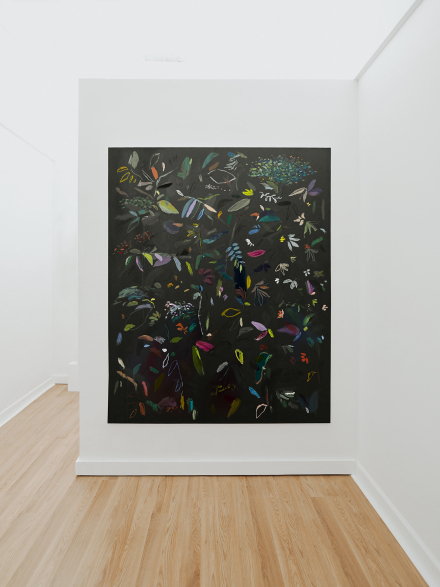
Sophie Kitching, Nocturne, 3A Gallery, all photos by Migle Staniskyte
For her latest exhibition on view at 3A Gallery, Sophie Kitching presents new paintings from her Nocturne series, a shadowy and dreamy companion to her Invisible Green series, started in 2019. Both the Nocturnes and the Invisible Green paintings incorporate images of bright flowers and leaves as their main subject matter, but the former is painted onto a background made of black ink mixed with Payne’s gray whereas the latter is on a white canvas. The contrast of both and indeed the title itself—Nocturne—alludes to the opposites representing night and day versions of one another, but moreover they tell a subtle tale of light versus shadow and express entirely different temperaments and moods.
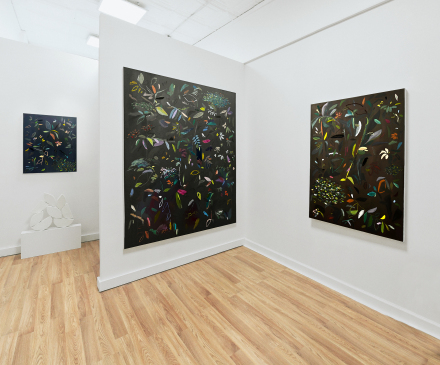
Sophie Kitching, Nocturne, 3A Gallery
Nocturne also refers to the 19th century musical compositions of the same name. These pieces of music were originally intended to be played in the evening time and are evocative of the feeling and ambiance of the night. The natural petal and leaf-like shapes within the paintings, are made up of quick, but intentional brushstrokes, drips, and patterns, and elicit a sense of movement and musicality. Kitching sometimes goes over the lines and shapes with bright pastels or charcoal. The use of both whimsical and somber colors likewise conjures a sense of music and mood as they ferry the viewer through a tonal progression on the canvas. Within the darker parts of the painting there is a sense that the viewer cannot see everything in the landscape clearly – some things are obscured by shadow and night.
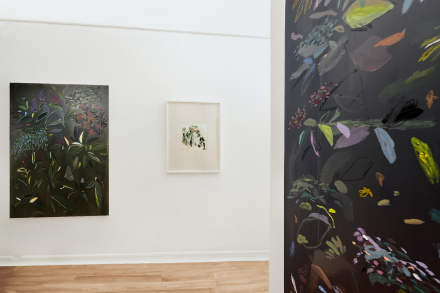
Sophie Kitching, Nocturne, 3A Gallery
The paintings are not a portrait of one singular landscape, but rather a combination of many. There is no horizon line within the paintings, there is no border, and the use of varied bright and dark colors gives the viewer the sense that the flowers are simultaneously close and at a distance. “As far as the mind can see,” a line in the artist’s poem, included in the press release, but perhaps also a nod to the Lawrence Weiner piece As far as the eye can see (1988). The depicted nature in the paintings is deep, dense, and enveloping; one cannot see past the flowers and leaves, except through our imagination.
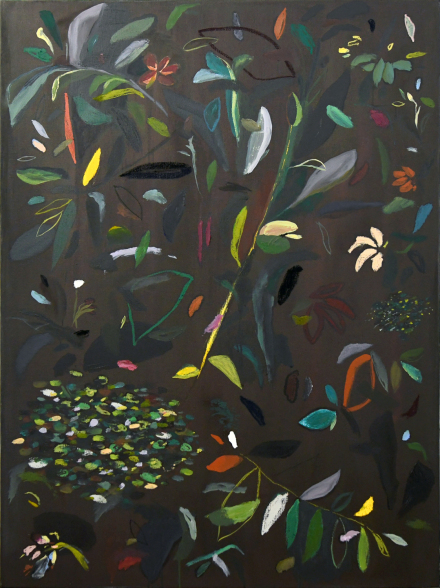
Sophie Kitching, Nocturne VIII (2023)
Kitching has a fascination with the 18th and 19th century that isn’t always immediately obvious in her work, but it crops up throughout. A time period of immense change and social upheaval, it also brought many scientific discoveries and inventions including that of the colors Payne’s Gray and Invisible Green. Before using the dark blue-gray color as the background to the Nocturne series, Kitching first used it in a monochromatic series entitled Payne’s Monochromes (2018-2022). The color was named after 18th century English watercolor artist, William Payne, and has been described more recently in 2011 as the color of “English Rain” by painter George Shaw. Kitching’s use of Payne’s gray in the Nocturnes lends itself to a rainy, dreamy, lush nighttime, where shadows play tricks.
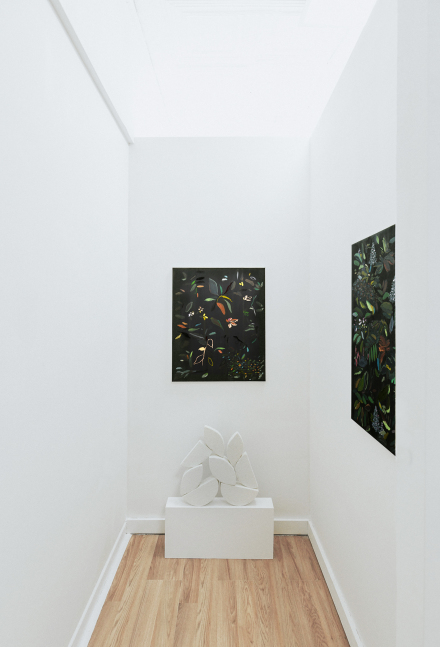
Sophie Kitching, Nocturne, 3A Gallery
Invisible Green on the other hand is a dark green color that came to be used to paint ironwork in natural settings, in an attempt to make the man-made structures blend in so as not to obscure the landscape—i.e. make invisible. This treatment is referenced in a poem from 1783 by William Mason, entitled “The English Garden,” and was an inspiration for the series. Kitching, who is both British and French but currently lives in NYC, draws upon various memories and personal photographic references of English gardens to create both the Nocturne and Invisible Green series. Some of these photo references are also on view in the exhibition. The style of the English Garden emerged originally in the 18th century as an informal garden approach—idyllic and pastoral. Gardens, by definition, are natural and wild, whilst simultaneously being curated and trimmed; controlled to some degree. Kitching’s paintings explore this margin between control and nature.
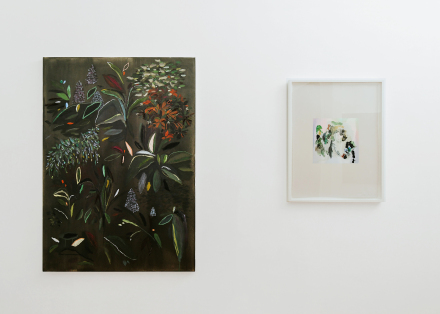
Sophie Kitching, Nocturne VI (2022) and Mirror & stones V (2016)
The idea and imagery of the garden appear in many other series by Kitching, and particularly in earlier installations Home Grown Gardens (2016-2022) and Octogardens (2017-2019), the latter a series inspired by the sailor’s valentine— sentimental souvenir boxes, made mostly in the 19th century, that sailors would fill with shells they collected during their travels to send to their loves at home. Kitching fills her boxes with various elements: glass, rocks, shells, photos, and the result resemble miniature gardens. They also recall the work of Joseph Cornell, containing an unspoken narrative and a small world very much alive, yet contained within each one.
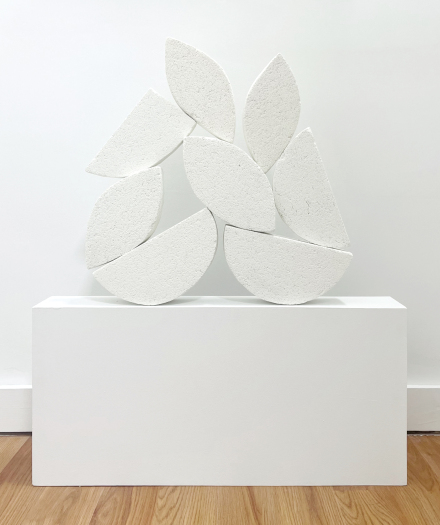
Sophie Kitching, Phases (2023)
Also on view in the current exhibition are a number of sculptures which echo the natural, leaf-like shapes seen within the paintings. Though unlike the dark, yet colorful paintings, the sculptures are devoid of color, and built to be freestanding without the need of support. Kitching started this sculpture series in 2018, occasionally combining different elements such as lemons with the predominantly white sculptures made from industrial cement and brick, and sometimes limestone material.
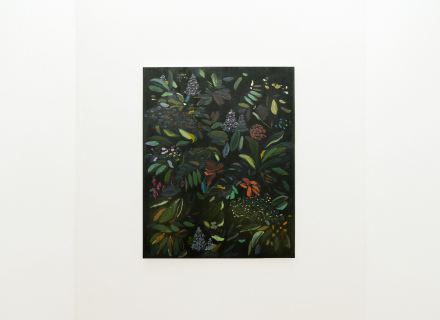
Sophie Kitching, Nocturne XI (2023)
3A gallery is intimate, small in scale, and smack-dab in the middle of a very busy New York City neighborhood, but through her work Kitching offers us up scenes from which to escape, creating a depth of place and a dreamy setting to step into and get lost.
Sophie Kitching: Nocturne is on view through February 26th.
— A. Marchak
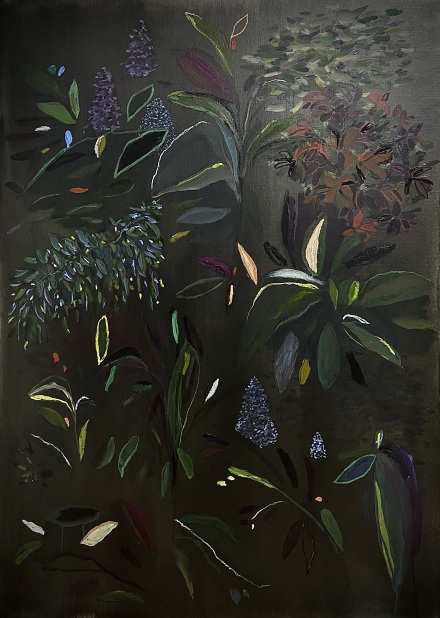
Sophie Kitching, Nocturne VI (2022)
Photos by Migle Staniskyte
Read more:
3A Gallery [Gallery Site]
Sophie Kitching [Artist Website]



